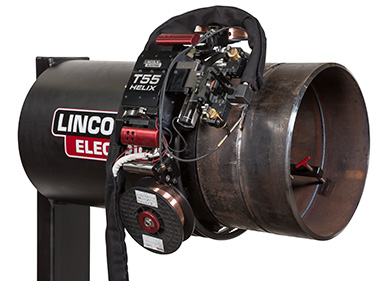In some types of automated or semi-automated welding processes, a positioning device known as a cross-slide mechanism is used to move a weld head assembly relative to the weld seam to ensure proper tracking during welding. The steering process used to drive the cross-slide mechanism so that the weld head or torch follows the weld seam can be automated through the use of a closed-loop laser seam tracker—or with an open-loop system using a handheld pendant in combination with a Weld Camera.
The open-loop Weld Camera option is often preferable because it provides operators with visibility of the weld area and its immediate environment—allowing more-precise human judgment to be used in quality control.
How a Weld Camera Helps
Cross-slide mechanisms are generally set up in one of two ways:
- The weld torch is fixed in position and the material to be welded is moved past the torch. Typical examples of this are when a drum rotates the material underneath the weld head or when a slide moves the material in a linear manner under a weld head. In both cases, the material is moved and needs its position to be adjusted relative to the fixed weld torch.
- The material to be welded is fixed and the weld torch moves relative to the material. A typical example of this is a welding tractor that moves a weld torch along a large fixed seam such as on a pressure vessel or in shipbuilding.

Orbital Welding Unit With a Cross-Slide Mechanism
The greatest benefit of using a Weld Camera to guide cross-slide mechanisms is that it can provide a clear view of the weld arc, the feeder wire, the seam, and the workpiece detail all in one image, allowing the operator to continuously monitor a live process for weld alignment. A secondary benefit can be achieved if the camera can be configured to see inside the weld arc to monitor the conditions of weld underfill (the condition in which insufficient material has been deposited in a weld bead during welding to fill a gap) and weld undercut (the condition in which excessive heat or current melt the parent material, creating a reduction in the cross-sectional area of the weld).
When a Weld Camera is mounted on a cross-slide mechanism, it is typically fixed relative to the torch, giving the user a point of view from the perspective of the torch. The user is able to monitor the wire stick-out from the torch and use it as a pointer to align the torch with the seam to control the lateral position.
On the Xiris XVC-O Weld Camera, multiple crosshairs can be implemented to help the user determine various weld parameters, such as the torch height from the seam, the lateral torch-seam alignment, and the quality of wire feed of the weld head. Because crosshairs provide minimum and maximum crosshair markers on the screen, they can also be used to keep the seam within a defined range relative to the torch.
An operator with a Weld Camera can often do a better job at tracking a seam than a laser seam tracker. The handheld pendant used in conjunction with a Weld Camera drives X, Y, or Z axes on a cross-slide mechanism to control the lateral position, height, or depth (respectively) of the weld torch position relative to the work material. These axes are typically driven by an open-loop motor, such as a stepper motor without an encoder.
Monitoring the image from a Weld Camera, an operator can see the results of adjustments in real-time on the image. Occasional torch/material alignment adjustments are necessary because the seam will tend to wander with respect to the torch over time due to slight misalignments in the motion system that moves the torch relative to the workpiece, or because the workpiece edge itself is not a perfect straight line or prepared with a perfect edge.
Conclusion
Typically, the best way to guide a cross-slide mechanism is for operators to use a handheld pendant and a Weld Camera with High Dynamic Range. Operators are usually more-accurate and more-effective than a closed-loop laser seam tracker because they can see more of the weld detail and its immediate weld environment in real time and make instant in-process adjustments, thereby tolerating process variations better than laser seam trackers can.
Image courtesy of www.arcproducts.com.
For more videos and sources visit our online welding camera library




.png)


